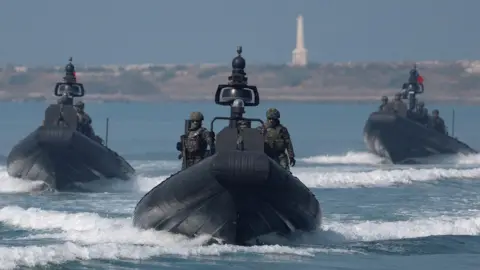Summary
- Taiwan President Lai will transit through Hawaii and possibly Guam, sources say.
- Lai is visiting Pacific allies: the Marshall Islands, Tuvalu, and Palau.
- China has conducted two rounds of war games near Taiwan this year.
- The military drills are aimed at sending a message to the incoming Trump administration.
TAIPEI, Nov 27 (Reuters) – China is likely to launch military drills near Taiwan in the coming days, using President Lai Ching-te’s upcoming trip to the Pacific and his scheduled U.S. transit as a pretext, according to Taiwan and regional security officials.
Lai will visit Taipei’s three diplomatic allies in the Pacific on Saturday. Sources told Reuters that he plans to stop in Hawaii and possibly Guam in a sensitive trip that comes shortly after the U.S. election. Beijing, which views Taiwan as its territory and the most important issue in its relations with Washington, strongly dislikes Lai, whom it calls a “separatist.”
Lai’s office has not yet confirmed the details of what are officially stop-overs in the United States, but sources familiar with the trip said he is expected to confirm the details shortly before departure.
Four regional officials, who requested anonymity due to the sensitivity of the issue, said China could conduct military maneuvers around or shortly after Lai’s trip, which ends on Dec. 6. According to a Taiwan security official, Beijing might “repackage” its ongoing regular military activities in the South China Sea or the East China Sea, moving them closer to Taiwan and rebranding them as “Joint Sword – 2024C.”
China could also expand the scale of its regular “joint combat readiness patrol,” which typically involves naval and air force drills near Taiwan during Lai’s visit. The source added that between 20 and 30 Chinese naval vessels are currently engaged in ongoing military maneuvers in the South China Sea.
‘RED LINE’
Beijing wants to show President-elect Donald Trump’s incoming U.S. administration that the first island chain is “China’s sphere of influence,” and Lai’s trip could serve as a “pretext,” the official said. This area stretches from Japan through Taiwan, the Philippines, and on to Borneo, enclosing China’s coastal seas.
“Beijing hopes to draw a red line and assert its power” during the U.S. government transition, aiming to expand its sphere of influence, the official added, noting that the military drills would target the United States and its allies.
A second source, a Taiwan-based regional security official, suggested that the drills would likely be more limited in scope than the two previous rounds this year, due to unstable winter weather conditions in the Taiwan Strait.
A third source, familiar with security assessments around Taiwan, said China might use exercises in the coming weeks to test the limits of the Trump administration.
Two of the sources indicated that more favorable weather conditions could lead to an earlier or delayed show of force around Lai’s trip.
Taiwan presidents typically use stop-overs in the United States, while traveling to and from distant allies, to deliver speeches and meet with supportive politicians. Lai will visit the Marshall Islands, Tuvalu, and Palau, three of the 12 remaining countries that maintain official diplomatic ties with Taipei.
It would not be unprecedented for China to respond militarily to Lai’s trip. China did so in August of last year when then-Vice President Lai returned from the United States, and again in April of the same year after then-President Tsai Ing-wen returned from California.
Lai and his ruling Democratic Progressive Party reject Beijing’s sovereignty claims, asserting that only Taiwan’s people can decide their future.

